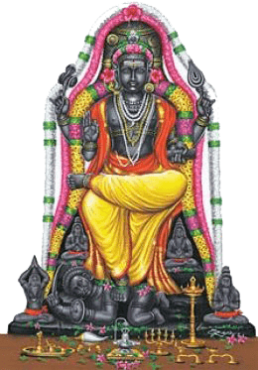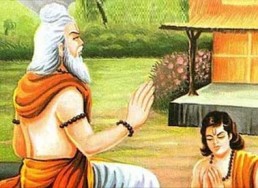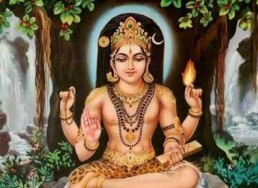Guru Ashtakam
गुरोरङ्घ्रिपद्मे मनश्र्चेन लग्नं ततः किं ततः किं ततः किं ततः किं ||1||
guroraṅghripadme manaśrcena lagnaṃ tataḥ kiṃ tataḥ kiṃ tataḥ kiṃ tataḥ kiṃ ||1||
गुरोरङ्घ्रिपद्मे मनश्र्चेन लग्नं ततः किं ततः किं ततः किं ततः किं ||2||
guroraṅghripadme manaśrcena lagnaṃ tataḥ kiṃ tataḥ kiṃ tataḥ kiṃ tataḥ kiṃ ||2||
गुरोरङ्घ्रिपद्मे मनश्र्चेन लग्नं ततः किं ततः किं ततः किं ततः किं || 3||
guroraṅghripadme manaśrcena lagnaṃ tataḥ kiṃ tataḥ kiṃ tataḥ kiṃ tataḥ kiṃ || 3||
गुरोरङ्घ्रिपद्मे मनश्र्चेन लग्नं ततः किं ततः किं ततः किं ततः किं ||4||
guroraṅghripadme manaśrcena lagnaṃ tataḥ kiṃ tataḥ kiṃ tataḥ kiṃ tataḥ kiṃ ||4||
गुरोरङ्घ्रिपद्मे मनश्र्चेन लग्नं ततः किं ततः किं ततः किं ततः किं ||5||
guroraṅghripadme manaśrcena lagnaṃ tataḥ kiṃ tataḥ kiṃ tataḥ kiṃ tataḥ kiṃ ||5||
गुरोरङ्घ्रिपद्मे मनश्र्चेन लग्नं ततः किं ततः किं ततः किं ततः किं || 6||
guroraṅghripadme manaśrcena lagnaṃ tataḥ kiṃ tataḥ kiṃ tataḥ kiṃ tataḥ kiṃ || 6||
गुरोरङ्घ्रिपद्मे मनश्र्चेन लग्नं ततः किं ततः किं ततः किं ततः किं ||7||
guroraṅghripadme manaśrcena lagnaṃ tataḥ kiṃ tataḥ kiṃ tataḥ kiṃ tataḥ kiṃ ||7||
गुरोरङ्घ्रिपद्मे मनश्र्चेन लग्नं ततः किं ततः किं ततः किं ततः किं ||8||
guroraṅghripadme manaśrcena lagnaṃ tataḥ kiṃ tataḥ kiṃ tataḥ kiṃ tataḥ kiṃ ||8||

Description
In Hinduism, a Guru is a spiritual teacher who imparts the higher knowledge of the Vedas and the way of achieving liberation (enlightenment). But mere study of books cannot make one a Guru. One who has studied the Vedas, and who has direct knowledge of Atman (soul) through self-realization can only be enrolled as a Guru. A Guru is knowledgeable, self-realized, liberated, chaste, virtuous, austere, truthful, detached, free from lust and delusion, and dedicated and devoted to God. A Guru is the knower of Brahman. A Guru is God in human form. The words of a Guru are like the words of God.
A popular Hindu prayer declares, “The Guru is Brahma, the Guru is Vishnu, the Guru is Shiva, the Guru is verily the Supreme Absolute itself. To that Guru, I offer my salutations.”
Paying respects to a Guru, touching the feet of a Guru, serving the Guru and taking care of his personal needs, praising and appreciating a Guru, seeking the blessings of a Guru, remembering and meditating on the name of a Guru, are the parts of Hindu spiritual traditions. But it doesn’t insist that everyone should have a Guru in physical form. In Hinduism, there is a provision to consider a sacred scripture, a deity or our very Self as our guide and Guru and develop a mental and intuitive connection with them. With the help of concentration, austerities and self-purification, we can strengthen our faith in our personal Guru of the subtle realm and seek his help either to introduce us to a real Guru, or lead us towards light, knowledge and immortality.
Glory of a Guru
According to the Vedas, Lord Vishnu imparted teachings to the sages in ancient times. Starting from the beginning, Lord Vishnu taught Lord Brahma, who in turn taught Sage Vyasa, who in turn taught Sage Shuka; a succession of Gurus and disciples has proceeded down through the ages through Shri Shankaracharya to the present. A Guru is absolutely necessary for every aspirant in the spiritual path. God is the goal, whereas Guru is the path.
All great ones had their teachers. All the sages, saints, prophets, world-teachers, incarnations, great men, however great they might have been, had their own Gurus. Shvetaketu learnt the nature of Truth from Uddalaka, Maitreyi from Yagnavalkya, Bhirgu from Varuna, Narada from Sanatkumara, Nachiketas from Yama, Indra from Prajapati; and several others humbly went to the wise ones, observed strict brahmacharya, practiced rigorous discipline and learnt the science of God from them. Even the incarnation of Lord himself, like Lord Krishna, sat at the feet of his Guru Sandeepani. Lord Rama had Guru Vasishtha, Lord Hanuman had Guru Surya (the Sun God). The Devas (celestial beings) have Brihaspati as their Guru, and even the greatest among the divine beings sat at the feet of Guru Dakshinamurti.
The scriptures are like a forest. There are ambiguous passages. There are passages that are apparently contradictory. There are passages that have esoteric meanings, diverse significance, and hidden explanations. There are cross-references. One is in need of a Guru or a preceptor who will explain to him the right meaning, who will remove doubts and ambiguities, and who will place before him the essence of the teachings.
Other Guru Shlokams
Guru Brahma
Guru Brahma - Known as Guru Mantra or Guru Mahamantra. The guru is Brahma (Bramha) the guru is Vishnu, the guru is Maheshwara (Siva), the guru is the Self-revealing limitless Brahman. Salutations to that revered guru. - In Sanskrit with English…
Guru Paduka Stotram
Guru Paduka Stotram is a very powerful chant that glorifies the "Padukas (Sandals) of the Guru," which are symbolically represented as "the boat to help cross the endless ocean
Guru Sishya Parampara
Guru-Sishya Parampara is the teacher-disciple lineage. Being a civilization that respects experiential knowledge, we hold high respect for the teacher of such knowledge. Below
Guru Stotram
Guru stotram is a selection of 14 verses from the Guru Geeta, found in Skanda Purana. It is a conversation between Lord Shiva & Parvati on the glory of the Guru. Gu – Darkness. Ru – Remover.
Ishvaro Guru Atmeti
Shlokams,Shiva,Dakshinamurthy,Guru,Sankara
Salutations to Lord Dakshinamurti, who is all-pervasive like space but who appears (as though) divided as Lord, Guru, and the Self.
Sada Shiva Samarambam
Salutation to the lineage starting with lord Sadasiva, with Adi Sankara in the middle and continuing up to my immediate teacher.
Samasta Jana Kalyane
I salute, Shri Chinmaya, the noble teacher, the best of the knowers of Brahman (the highest Reality), and who full of compassion, is ever engaged in the welfare of all people.
Guru Astakam – Guru – In Sanskrit with English Transliteration, Translation and Meaning. Commentary for selected Shlokams.


